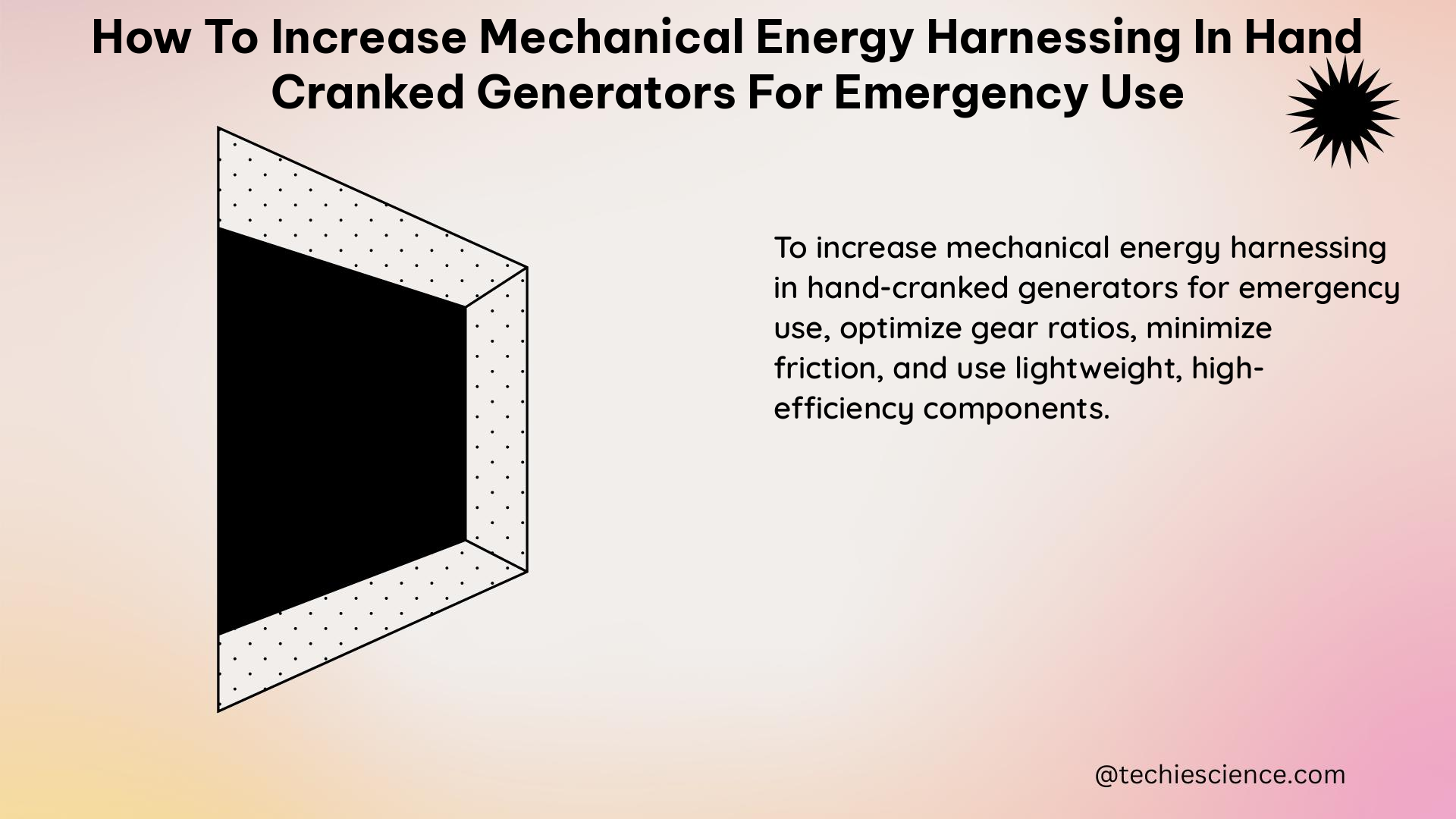Increasing the mechanical energy harnessing in hand-cranked generators for emergency use requires a deep understanding of the underlying physics and engineering principles. By optimizing the gear ratio, rotational speed, and input torque, the electrical power output of these generators can be significantly enhanced, providing a reliable source of power during critical situations.
Gear Ratio Optimization
The gear ratio is a crucial parameter that determines the rotational speed of the generator’s alternator. By increasing the gear ratio, the rotational speed of the alternator’s rotor can be amplified, leading to a higher electrical power output.
The gear ratio is defined as the ratio of the number of teeth on the driven gear to the number of teeth on the driving gear. Mathematically, the gear ratio can be expressed as:
Gear Ratio = N_driven / N_driving
where N_driven is the number of teeth on the driven gear, and N_driving is the number of teeth on the driving gear.
For example, the G-67B/G hand crank generator, developed by the US Army Research Laboratory, utilizes an 80:1 Harmonic Drive, which provides a high gear ratio and allows the alternator to rotate at high speeds, significantly increasing the electrical power output.
Rotational Speed Optimization

The rotational speed of the generator’s alternator is another critical factor that affects the electrical power output. By increasing the rotational speed, the electrical power output can be enhanced.
The relationship between the rotational speed (ω) and the electrical power output (P) can be expressed as:
P = T × ω
where T is the input torque applied to the generator.
To optimize the rotational speed, it is essential to consider the physical limitations of the human operator. Increasing the rotational speed may also increase the physical effort required to crank the generator, which may not be desirable in emergency situations.
Input Torque Optimization
The input torque applied to the generator is a crucial factor that determines the amount of mechanical energy transferred to the generator. By applying a higher input torque, more mechanical energy can be converted into electrical energy, resulting in a higher power output.
The input torque can be increased by various means, such as using a longer crank arm or applying more force to the crank. However, it is important to note that increasing the input torque may also increase the physical effort required to crank the generator.
The relationship between the input torque (T), rotational speed (ω), and electrical power output (P) can be expressed as:
P = T × ω
By optimizing the input torque and rotational speed, the electrical power output of the hand crank generator can be maximized.
Case Study: The Palm Power Energy Harvesting System
The Palm Power energy harvesting system, developed by High Tide Associates in cooperation with the US Army, is a hand crank generator that can charge an 8-volt battery and produce voltages near 12 VDC when charging a 12-volt battery.
The Palm Power unit weighs 1.3 lbs and occupies a 2 x 3.5 x 6 inch volume with its hand crank in the stowed configuration. The device has a 3.75-inch crank arm, and power outputs of 20+ watts are attainable with the unit, although the maximum output is dependent on the user’s capabilities.
Test and evaluation efforts conducted on the Palm Power system aimed to characterize the system’s performance through a range of cranking speeds and input drag torques. The testing provided investigations of the battery charging capabilities and overall system performance, as well as the optimal cranking speeds and torques for operating at peak efficiency.
The test setup utilized a 40-watt speed control motor and coupler to crank the removable unit at selectable speeds and torques. A 30 inch-pound in-line rotary torque sensor was used to measure the mechanical power input, and a non-contact RPM sensor (stroboscope) was used to verify the cranking speed.
The test results indicated peak system efficiencies around 50% while the Palm Power units were operated at mid-range torques and a cranking speed of 120 rpm (2 revolutions per second). In this range of operating points, the device generates 8 to 11 watts of electrical power, and the average male soldier can reasonably be expected to crank the unit for about 5 minutes.
Conclusion
Increasing the mechanical energy harnessing in hand-cranked generators for emergency use requires a comprehensive understanding of the underlying physics and engineering principles. By optimizing the gear ratio, rotational speed, and input torque, the electrical power output of these generators can be significantly enhanced, providing a reliable source of power during critical situations.
The case study of the Palm Power energy harvesting system demonstrates the importance of thorough testing and evaluation to determine the optimal operating parameters for maximizing the system’s efficiency and power output. By applying these principles, hand-cranked generators can be designed and optimized to meet the specific needs of emergency situations, ensuring a reliable and sustainable source of power when it is needed most.
References
- Hand Held Crank Generator, Driven Electricity, Amazon.com
- Hand Crank Generator – Demonstrate Energy Conversion, Home Science Tools
- HARVESTING ENERGY WITH HAND-CRANK GENERATORS TO SUPPORT DISMOUNTED SOLDIER MISSIONS, Weston L. Moyers and H. Scott Coombe, US Army RDECOM CERDEC Power Generation Branch, Fort Belvoir, VA 22060
- Harvesting Energy with Hand-Crank Generators to Support Dismounted Soldier Missions, DTIC
- 20W 3V-15V High Power Hand Crank Generator Portable Emergency USB Charger Generator for Outdoor Camping Survival Activities, Amazon.com

The lambdageeks.com Core SME Team is a group of experienced subject matter experts from diverse scientific and technical fields including Physics, Chemistry, Technology,Electronics & Electrical Engineering, Automotive, Mechanical Engineering. Our team collaborates to create high-quality, well-researched articles on a wide range of science and technology topics for the lambdageeks.com website.
All Our Senior SME are having more than 7 Years of experience in the respective fields . They are either Working Industry Professionals or assocaited With different Universities. Refer Our Authors Page to get to know About our Core SMEs.